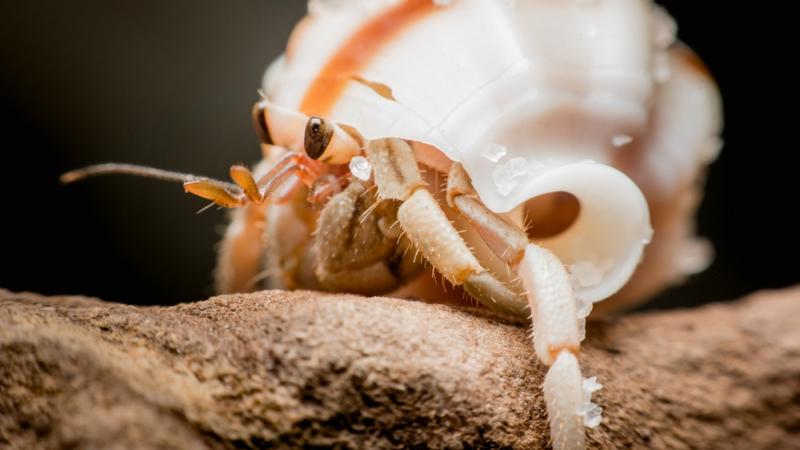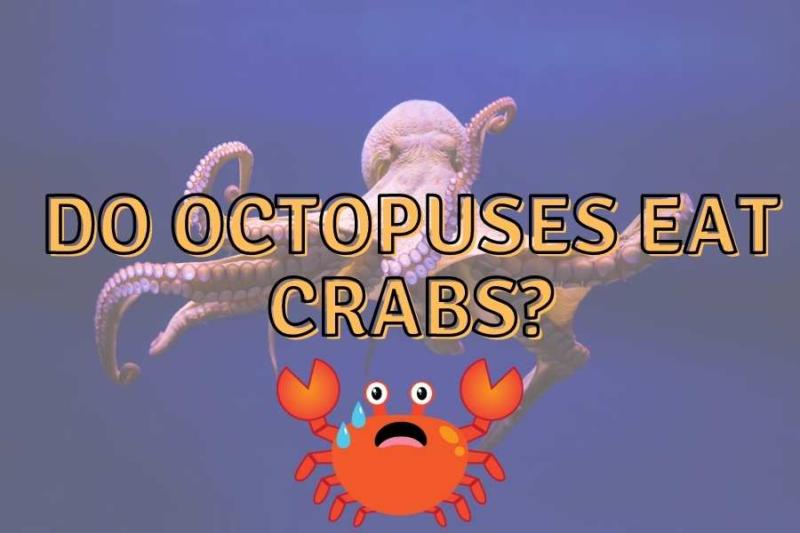Copepods, larval crabs, and sea stars are common meals for newly born octopuses. Crabs, clams, snails, tiny fishes, and even other octopuses are common foods for adult octopuses
Yes, octopuses do eat crabs and they devour them by holding them tight with using their suckers. Then, they penetrate the exoskeleton of the crab with their beak and paralyze their prey with poisonous saliva.
Despite their venom, most octopus species pose a minor threat to people. The bacteria that dwell in the octopus’ salivary glands are the true culprits in those that are.
What Kind of Crabs do Octopuses Eat?
Newly hatched octopuses will eat, among other things, larval crabs. As the Octopus grows, so it will widen the selection of crabs that it will eat. The size of the octopus is the crucial factor in deciding what crab is on the menu. Crabs are one of the favorite foods enjoyed by an octopus. They will choose crabs over any other food source.
- Octopus are known to eat ghost crabs and mud crabs.
- The Tropical Octopus Insularis is the primary predator of the invasive Portunidae swimming crab off the coast of Brazil.
- The Atlantic Octopus Joubini is a predator of the Fiddler crab. It can kill and devour a fiddler crab in less than a minute.
- With Spider Crabs, the Octopus will certainly eat any of them it can overpower. However, Spider Crabs will also happily eat octopus.
Can an octopus also eat hermit crabs?
When an octopus stares them down, hermit crabs have limited escape options, largely because an octopus has three methods to take a hermit crab out of its shell and consume it.
An octopus can extract a shellfish from its shell by covering it with saliva, which eats away at the hard exterior, according to Alaska Pacific University.
The octopus next uses an organ called a radula to bore into the shell. Octopuses may also pry open and crush shells.
Some hermit crabs, as well as the pom-pom crab, have an interesting alliance with anemones.
When the crab eats, remnants of the crab’s meal fall to the anemone, who consumes the remains.
When the anemone rides the crab, it is exposed to a greater region where it may seek food.
The crab and anemone are symbiotic, which means they coexist in peace. They have a mutualistic connection. They both benefit from the partnership.
The hermit crab grabs the anemone and places it on its shell to protect it from the octopuses who consume them. When the crab grows large enough, they remove the anemone out of its shell and bring it with them. They are lifemates!

Scientists are unsure whether the hermit crab communicates a possible threat to the anemone by mechanical or chemical means, but the anemone responds to the signal in the same way.
The sea anemone drapes a brilliant pink canopy of stinging threads over the hermit crab. As added defense, the anemone stretches its stinging tentacles.
If a hermit crab is accompanied by an anemone, he is less likely to be eaten by an octopus.
Do Octopuses Eat Crayfish or Lobsters?
Octopuses do usually not meet crayfish as they are freshwater animals and octopuses are only found in the saltwater of the sea.
However, octopuses do eat lobsters and this can cause problems for the lobster fishing industry.
Warming ocean temperatures are causing an increase in the number of octopuses, which is endangering W.A. Fisher Co. valuable rock lobster fishery, according to one of the state’s largest commercial fishers.
Mike Thompson, who controls a $200 million lobster fishing business with his brother David, wants investigation into the consequences of growing octopus numbers, which he claims are costing the sector up to $10 million per year.
The creatures’ growing numbers posed a direct danger to the western rock lobster fishery, WA’s most profitable, with annual sales worth $400 million.
Octopuses are natural predators of lobsters and can attack them by invading the traps often employed by commercial fishermen off the coast of Western Australia.
The losses were being exacerbated by the harm the lobsters did on themselves, trying to fend off the predators.
What Kinds of Octopuses Eat Crabs?
Over 300 species of octopus have been found by scientists throughout the world’s waters. Octopi range in size from little to enormous.
These creatures are carnivorous, which means they eat flesh. They include crustaceans, which are animals with a hard shell and numerous pairs of legs that live in water. Crustaceans include crabs, lobsters, and shrimp.
Deep-sea Finned Octopus
The Deep-sea Finned Octopus is a carnivorous animal that feeds on small fishes, crabs and squid. It is found in the deep waters of the Pacific Ocean, from Japan to Australia. The octopus uses its eight arms to catch prey and then sucks out the contents with its beak.
The ecology of the Deep-sea Finned Octopus is largely unknown, but it is thought to live in solitude or in small groups. This octopus has few predators due to its depth of habitat; however, large sharks and other fishes may feed on them occasionally.
They mainly eat: Crustaceans, including small crabs, worms, bivalves, and copepods.
Giant Pacific Octopus
The giant Pacific octopus is a voracious predator, feeding on crabs, shrimp, fish, and even other octopuses. They use their powerful suckers to pry open shells and pull their prey into their mouths. They also have been known to attack humans!
The giant Pacific octopus is found in the coastal waters of North America from Alaska to California. They prefer cool, deep waters and are often found near kelp forests or rocky reefs.
Octopuses are not very efficient at digesting food and so they excrete a lot of it as waste. This wasted food provides an important source of nutrients for other animals in the ecosystem like fishes, crustaceans, and mollusks.
They eat: Crabs, small fishes, clams, snails, other octopuses and even sharks!
Blue-ringed Octopus
The blue-ringed octopus diet typically consists of small crabs. To eat its prey, the octopus will first paralyze the crab with a venomous bite. It will then rip the crab apart and consume it whole.
Hermit shrimp, small crabs, and small fishes.
Common Octopus
The Common Octopus is a carnivorous octopus that eats crabs as part of its diet. It is found in tropical and temperate waters all over the world. The octopus uses its beak to drill into the crab’s shell and break it open, then it sucks out the crab’s meat.
It also eats Gastropods (such as snails and slugs) and bivalves.
How Does an Octopus Eat a Crab?
Octopuses consume crustaceans, fish, and clams and mussels, with certain species preferring clams and mussels. But the way they consume them is a little gruesome. They murder or paralyze their prey with deadly saliva.
All octopus species have a toxic venom, which they inject into the crabs with a beak similar to a bird’s.
All octopus species have varying degrees of toxicity in their venom, but it helps them paralyze their prey quickly.
They hunt at night, pounce on prey, and encircle it in the webbing between their arms. Their beaks are used to puncture hard-shelled prey.
The octopus utilizes its beak to bite its prey, but it also uses the salivary glands to store the neurotoxic that paralyzes the crab and to store enzymes that help break down the food inside the crab’s shell. The octopus literally turns the insides of this crab into a milkshake.
How long does it take an octopus to eat a crab?
Once the octopus has located and grabbed the crab, it will take just two or three minutes to crack into its shell with its beak and inject the toxins that paralyze them. It also injects enzymes that liquify the crabs’ insides.
How does an octopus eat a crab without getting cuts?
An Octopus immediately understands where the crab’s “dangerous end” is. Before taking a shot or making a grab, cuttlefish and octopuses reflexively zip around to their backsides. They can then overwhelm the crabs.
They immediately wrap their many legs around the claws, break them open with their beak, and inject them with paralyzing chemicals. The crab, even with claws, have little chance of defending itself.
Conclusion
In this blog, I have shown you how an octopus can eat crabs in a sneaky way and as well as other animals like sharks, snails and more.
Octopuses will eat anything and are known for being a very smart animal.
I hope this blog post has helped you with understanding which octopuses eat crabs and how they do it. If you are more interested I have written about the “teeth” of octopuses and how they can even overcome sharks for dinner!




